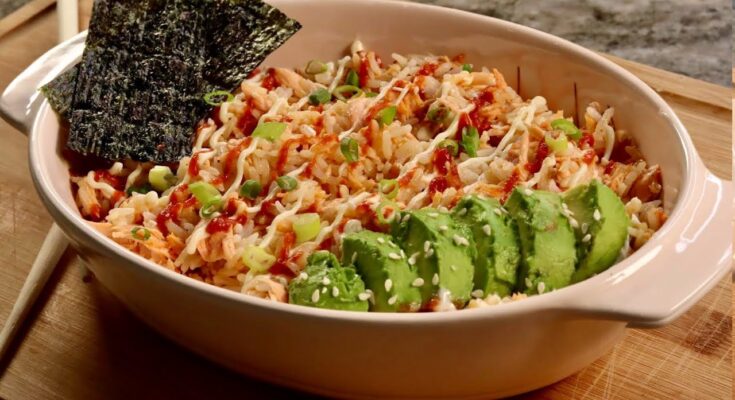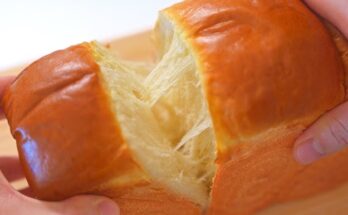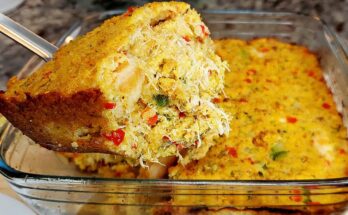Salmon Bowls Recipe: Craving something healthy, flavorful, and super satisfying? Say hello to your new favorite go-to meal: the salmon bowl. It’s vibrant, versatile, and packed with nutrients. Whether you’re looking for a quick weeknight dinner or something that meal preps like a champ, this recipe covers all the bases.
In this guide, you’ll get a complete breakdown of how to make the ultimate salmon bowl from scratch—with bold flavors, fresh toppings, and that perfect balance of protein, carbs, and veggies. Ready to level up your lunch or dinner game? Let’s dive in.
What Are Salmon Bowls?
Salmon bowls are exactly what they sound like—a hearty, balanced bowl of deliciousness centered around perfectly cooked salmon. Think of them as customizable, power-packed meals that bring together juicy, flaky fish with rice, fresh vegetables, creamy sauces, and tons of flavor. You’ve probably seen them in trendy cafes or Instagram feeds, and now you’ll learn how to bring that same energy into your kitchen.
What makes salmon bowls special is their adaptability. You can go with Asian-inspired flavors like soy, ginger, and sesame. Or, take it Mediterranean with olive oil, lemon, and feta. Craving something spicy? Throw in some chili garlic sauce or a sriracha-mayo drizzle. It’s all about building layers of flavor and texture in a single bowl.
Another perk? These bowls aren’t just tasty—they’re nutrient-dense. Salmon is rich in omega-3 fatty acids, high-quality protein, and essential vitamins. Paired with whole grains and veggies, it’s the kind of meal your body and taste buds will thank you for.
Why You’ll Love This Recipe
Here’s why salmon bowls might just become your new kitchen obsession:
- Quick and Easy: With just 30 minutes from start to finish, you can whip up a bowl faster than ordering takeout.
- Customizable: From the grain base to the toppings and sauces, you can mix it up every time.
- Meal-Prep Friendly: Make a few servings in advance, and you’ve got lunch or dinner covered for days.
- Healthy Yet Indulgent: It hits that rare combo of being both nourishing and crave-worthy.
This recipe doesn’t require any culinary wizardry—just a few good ingredients, a hot skillet or oven, and a little creativity. You’re going to love how satisfying it is to put together a bowl that’s both beautiful and delicious.
List of Ingredients You’ll Need
Main Ingredients
Let’s start with the basics. Here’s everything you’ll need to build a solid salmon bowl foundation:
- Salmon Fillets (skin-on or skinless): Fresh or frozen, wild-caught is best for flavor and sustainability.
- Rice or Grains: White rice, brown rice, jasmine, quinoa, or even cauliflower rice for a low-carb option.
- Fresh Veggies: Think cucumber, avocado, shredded carrots, radishes, red cabbage, or edamame.
- Oil: Olive oil, avocado oil, or sesame oil for cooking the salmon.
- Seasonings: Salt, pepper, garlic powder, paprika, chili flakes, or a spice blend like everything bagel seasoning.
These essentials create the base for your bowl—flaky salmon, hearty grains, and colorful veggies. But we’re not stopping there.
Topping & Garnish Options
Here’s where the flavor party really kicks off. Toppings take your bowl from basic to brilliant:
- Green onions or chopped cilantro for fresh, herby notes
- Sesame seeds for crunch
- Pickled ginger or kimchi for a tangy kick
- Crushed seaweed (nori flakes) for umami
- Chili crisp or sriracha for heat
- Sliced avocado for creaminess
- Microgreens or sprouts for a gourmet touch
Feel free to mix and match depending on your mood and pantry stock.
Substitution Suggestions for Dietary Needs
No matter your dietary style, salmon bowls can work for you. Here’s how to tweak things:
- Gluten-Free: Use tamari or coconut aminos instead of soy sauce.
- Low-Carb/Keto: Swap rice for cauliflower rice or zucchini noodles.
- Dairy-Free: Avoid creamy dressings with yogurt or mayo—opt for vinaigrettes or tahini-based sauces.
- Vegan: Swap salmon for grilled tofu or tempeh and follow the same steps.
The goal? A bowl that fits your lifestyle without compromising flavor.
Essential Kitchen Tools for Making Salmon Bowls
Cooking Equipment
While you don’t need fancy tools, having the right gear can make the process smoother:
- Non-stick skillet or grill pan – Ideal for pan-searing salmon with crispy skin.
- Oven or Air Fryer – Great for a hands-off cooking option.
- Medium saucepan or rice cooker – For cooking your grain base perfectly.
These tools help ensure your salmon is cooked just right, and your grains come out fluffy, not mushy.
Prep Tools
Efficient prep is key to fast and fresh salmon bowls:
- Sharp chef’s knife – To slice veggies thin and even.
- Cutting board – Use separate boards for fish and veggies.
- Mixing bowls – For marinades, sauces, and tossing ingredients.
- Tongs or spatula – For flipping your salmon safely.
When you have the right tools ready to go, cooking becomes more enjoyable—and less messy.
Step-by-Step Guide to Making Salmon Bowls
Step 1 – Prepare Your Salmon Fillets
Start with fresh or thawed salmon fillets, about 4–6 ounces each. Pat them dry with paper towels to remove excess moisture — this helps them sear beautifully. Remove any pin bones with tweezers if needed, and cut the fillets into bite-sized chunks or keep them whole depending on your bowl style.
Step 2 – Marinate the Salmon
In a bowl, whisk together your marinade ingredients — a mix of soy sauce, honey or maple syrup, minced garlic, ginger, sesame oil, and a splash of lime juice works wonders. Place the salmon in the bowl and coat evenly. Let it marinate for 15–30 minutes in the fridge. The longer it sits, the deeper the flavor — just don’t over-marinate, as the acid can start to “cook” the fish.
Step 3 – Cook the Salmon Perfectly
You can pan-sear, bake, or air-fry the salmon depending on your preference.
- For pan-searing, heat oil in a skillet over medium-high heat and cook each side for about 3–4 minutes until golden and flaky.
- For baking, preheat your oven to 400°F (200°C) and roast for 10–12 minutes.
- For air-frying, cook at 390°F (200°C) for 7–8 minutes.
Whichever method you choose, aim for tender salmon that flakes easily with a fork.
Step 4 – Prepare the Rice or Grain Base
While the salmon cooks, prepare your base. Use steamed jasmine rice, brown rice, quinoa, or cauliflower rice for a lighter option. Season lightly with salt or drizzle with a bit of soy sauce or rice vinegar to enhance flavor. Fluffy, warm grains make the perfect foundation for your bowl.
Step 5 – Chop and Prep the Veggies
Now add color and crunch! Slice fresh veggies like cucumber, avocado, shredded carrots, edamame, or red cabbage. For extra zest, toss them lightly in a sesame-lime dressing. Arrange them around your rice base, then top with the cooked salmon.
Finish with a drizzle of spicy mayo, sesame seeds, or scallions, and you’ve got yourself a beautiful, nourishing salmon bowl — balanced, flavorful, and full of vibrant textures.
Step-by-Step Assembly of the Salmon Bowls
Layering the Base
Now that everything’s prepped and ready, it’s time to build your salmon bowl. Start by adding a generous scoop of your chosen grain base—whether it’s jasmine rice, quinoa, or cauliflower rice—into the bottom of a wide bowl. You want a solid, hearty foundation that soaks up sauces and compliments your toppings without overpowering them.
Make sure the rice is slightly warm but not steaming hot. This ensures your veggies stay crisp and your sauces cling beautifully to each ingredient. Want to level up the base? Add a sprinkle of furikake (a Japanese rice seasoning), sesame seeds, or a squeeze of lime for added depth.
The idea is to make your base the bedrock for everything that comes next. Neat layers look great for presentation, but don’t worry—this bowl is going to be mixed up before you devour it anyway!
Adding the Protein
Next up: the hero of your bowl—salmon.
Place your cooked salmon fillet right on top of the rice. If it’s skin-on, position the crispy side up for that photo-worthy texture. You can keep the fillet whole or flake it into chunks for easier eating and better distribution with each bite.
This is also your chance to add an extra drizzle of any pan juices or leftover marinade (if it was cooked), which can act as a delicious finishing sauce. Want to get fancy? Lightly torch the top of the salmon for that seared sushi look.
Remember, salmon is rich and fatty in the best way. It pairs well with both creamy sauces and acidic, tangy elements—so save room for those toppings.
Topping It All Off
Here’s where the real magic happens.
Pile on your chopped veggies in small groups or rows for a beautiful, Instagram-ready look. Think sushi bowl meets salad bar, but curated with intention. Add avocado slices for creaminess, shredded carrots for color, pickled ginger for tang, and radish for a peppery punch.
Then come the crunchy elements:
- Toasted sesame seeds
- Crushed nori
- Crispy shallots or fried onions
- Chopped nuts or seeds
Finally, don’t forget your garnishes—fresh herbs like cilantro or green onion, microgreens, or even edible flowers if you’re going gourmet. And of course, finish with your favorite sauce (we’re getting to that next), a squeeze of lemon or lime, and a sprinkle of sea salt or chili flakes.
Delicious Sauce Options for Salmon Bowls
Classic Teriyaki Drizzle
A sweet-savory teriyaki sauce is a classic choice that complements salmon beautifully. You can buy it pre-made, but making it at home is quick and way more flavorful. Here’s a simple version:
- ¼ cup soy sauce
- 2 tablespoons honey or brown sugar
- 1 tablespoon mirin or rice vinegar
- 1 clove garlic, minced
- 1 teaspoon fresh ginger, grated
- 1 teaspoon cornstarch + 1 tablespoon water (to thicken)
Combine all ingredients (except the cornstarch slurry) in a small saucepan. Bring to a boil, then reduce heat. Stir in the cornstarch mix and simmer until thickened. Drizzle generously over your salmon and bowl base for that glossy, umami-rich finish.
Spicy Mayo Sauce
Looking to bring some heat and creaminess? Enter: spicy mayo.
Mix together:
- 3 tablespoons mayo (or Greek yogurt)
- 1 tablespoon sriracha (adjust to taste)
- ½ teaspoon sesame oil
- A dash of lime juice
This sauce adds a tangy, spicy kick that cuts through the richness of the salmon and adds serious flavor to the veggies. Spoon or squiggle it over your bowl just before serving.
Creamy Avocado Lime Dressing
Want something fresh and light? This creamy green sauce doubles as a dressing and a dip.
Blend together:
- 1 ripe avocado
- Juice of 1 lime
- 2 tablespoons olive oil
- 1 tablespoon Greek yogurt
- 1 clove garlic
- Salt and pepper to taste
- Optional: handful of cilantro or parsley
The result is a zesty, velvety dressing that balances everything on the plate—especially if your toppings lean spicy or crunchy.
Pro Tips for the Best Salmon Bowls Ever
Cooking Tips
- Don’t skip the marinade. Even a quick 15-minute soak adds tons of flavor.
- Room temperature salmon cooks more evenly. Take it out of the fridge 10–15 minutes before cooking.
- Crispy skin? Pat the skin dry and don’t move it once it hits the pan.
- Use a thermometer if you’re unsure—salmon is done when it reaches an internal temp of 125°F–130°F for medium.
Flavor Pairing Advice
Balance is everything when it comes to building a perfect salmon bowl. Think:
- Rich + Acidic: Fatty salmon pairs beautifully with pickled veggies or a citrus splash.
- Spicy + Creamy: Spicy mayo or chili oil balanced with creamy avocado.
- Soft + Crunchy: Mix textures for a more exciting bite—crispy onions, seeds, and fresh veg work great.
Also, season each layer lightly. A pinch of salt on the rice, a touch of vinegar on the veg, a squirt of lemon on the salmon—it all adds up to a big flavor payoff.
Common Mistakes to Avoid
Overcooking the Salmon
Let’s face it—nothing ruins a salmon bowl faster than dry, rubbery fish. Salmon is delicate and cooks quickly. Overcooking not only drains the natural fats but also turns it tough and bland. Whether you’re pan-searing, baking, or air-frying, aim for medium to medium-well—it should be flaky, moist, and slightly translucent in the center.
Invest in a meat thermometer if you struggle with this. Pull the salmon once it hits 125°F, then let it rest—it’ll finish cooking in its own heat. If you’re pan-searing, don’t keep flipping the fish. Let one side cook undisturbed until a crust forms, then flip once.
Using the Wrong Rice
Rice isn’t just filler—it’s a critical flavor sponge and texture element in your bowl. Undercooked, gummy, or overly wet rice can throw off the balance completely. Be sure to rinse your rice thoroughly to remove excess starch and use the correct water ratio.
Also, choose the right type:
- Sticky sushi rice is great for Asian-inspired bowls.
- Brown rice or farro offers a nutty bite and higher fiber.
- Cauliflower rice is ideal for those going low-carb.
Don’t be afraid to lightly season the rice either—a splash of rice vinegar or lime juice goes a long way in brightening the whole dish.
Nutritional Information
Calories per Bowl
The beauty of salmon bowls is that they’re both nutritious and customizable. Depending on the ingredients and sauces used, a typical bowl ranges between 500–700 calories.
Here’s an approximate breakdown for one serving (without heavy sauces):
- Salmon (6 oz): 330 calories
- Brown Rice (1 cup cooked): 215 calories
- Vegetables (1 cup total): 50 calories
- Avocado (¼): 60 calories
- Sauce (1 tbsp): 40–80 calories
That puts your average bowl at about 650–700 calories, which is pretty balanced for a full, hearty meal.
Protein, Carbs, and Fats Breakdown
Let’s break it down a bit further:
- Protein: 35–45g (salmon + edamame or quinoa)
- Carbohydrates: 45–60g (rice, veggies)
- Healthy Fats: 20–25g (salmon, avocado, sesame oil)
This makes salmon bowls ideal for post-workout meals, balanced lunches, or even clean eating goals. Plus, they’re loaded with omega-3 fatty acids, fiber, vitamin D, and antioxidants.
How to Store and Meal Prep Salmon Bowls
Refrigeration Tips
Salmon bowls are awesome for meal prep. Cook once, eat multiple times. Here’s how to store them properly:
- Use airtight containers to keep ingredients fresh.
- Store salmon, rice, and veggies separately to maintain texture.
- Keep sauces in small condiment cups until ready to eat.
- Consume within 3 days for the best flavor and safety.
When reheating, do so gently—preferably in the microwave at 50% power for 1–2 minutes, or in a covered pan over low heat. Add a splash of water to the rice to rehydrate it.
Best Containers for Storage
For best results:
- Use compartment-style containers to keep items separate.
- Choose glass containers for reheating directly in the microwave or oven.
- For on-the-go options, use a thermos or insulated lunch box to maintain temperature.
Want to freeze the components? Only freeze the rice and cooked salmon. Avoid freezing fresh veggies or creamy sauces—they don’t thaw well.
Salmon Bowl Variations
Poke-Inspired Bowl
Go raw and refreshing with a sushi-style twist:
- Use sushi-grade raw salmon
- Add seaweed salad, pickled ginger, wasabi mayo, and soy sauce
- Top with furikake and edamame for extra texture
Mediterranean Salmon Bowl
Switch things up with a bold Mediterranean flavor profile:
- Use lemon-herb grilled salmon
- Base of quinoa or bulgur
- Add cherry tomatoes, cucumbers, red onion, feta cheese, and tzatziki sauce
Low-Carb or Keto Salmon Bowl
Watching carbs? No problem:
- Use cauliflower rice
- Load up on avocado, zucchini noodles, spinach, and olive oil drizzle
- Choose a lemon-garlic butter sauce instead of sugary marinades
Pairing Suggestions and Side Dishes
Best Beverages to Pair With
Pair your salmon bowl with light and refreshing drinks:
- Iced green tea
- Sparkling water with citrus
- White wine like Sauvignon Blanc or Pinot Grigio
- Cucumber or mint-infused water
Great Side Dish Options
Need something on the side? Try:
- Miso soup
- Seaweed salad
- Cucumber sunomono
- Kimchi or pickled daikon
- Steamed dumplings
These sides can elevate your bowl into a full dining experience while keeping it healthy and satisfying.
FAQs about Salmon Bowls Recipe
Can I make salmon bowls ahead of time?
Absolutely! Just cook the components and store them separately. Assemble when you’re ready to eat.
How long does cooked salmon last in the fridge?
Cooked salmon lasts for about 3 days in an airtight container. Make sure to keep it refrigerated at or below 40°F (4°C).
What’s the best salmon to buy for bowls?
Wild-caught Alaskan salmon is your best bet for flavor and sustainability. If that’s not available, choose fresh, skin-on fillets from a trusted source.
Can I freeze the bowl components?
Yes—freeze the cooked salmon and rice separately. Avoid freezing fresh veggies or sauces, as they lose texture when thawed.
Are salmon bowls healthy for weight loss?
Definitely! They’re rich in protein, healthy fats, and fiber. Use low-calorie sauces and control your portions for a weight-loss-friendly meal.
Conclusion
There you have it—your ultimate guide to crafting the perfect salmon bowl from scratch. Whether you’re going for quick weekday fuel or hosting a dinner with flair, salmon bowls deliver flavor, nutrition, and satisfaction in every bite. With just a few fresh ingredients and a little prep, you’ll have a beautiful, balanced meal that rivals any restaurant. The best part? It’s endlessly customizable, so you can tweak it to fit your taste buds and lifestyle.
So next time you’re staring into your fridge, wondering what to cook, remember this: when in doubt, bowl it out. Your taste buds (and your body) will thank you.



